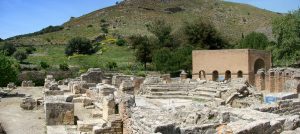Gortyn is located at the Messara Valley, near the village of Agioi Deka, on the 46th km of the main road from Iraklion to Tibaki that traverses the island from north to the south.
Gortyn is crossed by the river Lithaios, today called Mitropolianos, that dominates the valley of Messara.
The significance of the great ancient city of Gortyn is recognized and recorded in its rich mythological and religious tradition. Great gods, like Zeus, Europe and Demeter, but also semi gods, heroes and kings like Minos, Gortys, Rhadamanthys, as well as Iasion and the Minotaur play a leading role in its myths. Gortyn is also associated with the major figures of Christianity; the Apostles Paul and Titus, and the Holy Ten Martyrs.
Gortyn was one of the oldest and strongest cities in Crete during the prehistoric and historic period. The population of ancient Gortyn is believed to be 300.000 people. The Gortynians occupied Phaistos during the 3rd century B.C. During the Roman period reached the peak of its glory and it was the capital of Crete. Gortyn was the first city of Crete to accept Christianity, and maintained its glory until 828 A.D. when it was occupied and destroyed by the Saracens. Since then it was never inhabited again.
The most important monuments of the ancient Gortyn are the ruins of the acropolis and the Odeum. The odeum of the ancient city was the place where parts of the great Law Code of Gortyn was discovered. The Gortyn Law was inscribed on stones. Four series of inscribed stones are preserved today, which constitute relics of great importance for the study of the epigraphy and Law of the time. The inscription is in a Dorian dialect and it was written at the end of the 6th century B.C.
At the organized main archaeological site, visitors can see the Roman Odeum and the Great Inscription with the Law Code of Gortyn, the early Byzantine church of Saint Titus, and the Antiquarium next to the modern refreshment hall. Scholars and any other interested person can also visit the other major excavated monuments, providing they contact the Archaeological Service in advance and are accompanied by a warden.

 )
)







